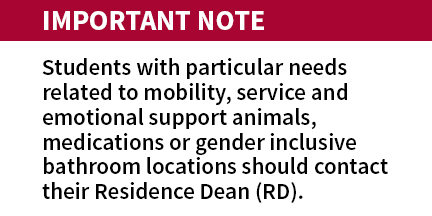What You Need To Know About Thriving In Your Student Residence At Stanford

A GUIDE FOR STANFORD STUDENTS TO STAY SAFE AND RESPOND TO EMERGENCIES
BUILDING SAFETY EQUIPMENT
Building health and safety equipment includes building access alarms and card readers, fire extinguishers and hoses, fire alarm pull boxes, smoke detectors, automatic door closers, fire sprinkler systems, fire horns and lights, exit signs, and evacuation maps. It is illegal to tamper with this equipment; violators will be subject to an administrative fee of $500 or more, university disciplinary action, and criminal penalties.
SMOKE-FREE ENVIRONMENT
Stanford University promotes a smoke-free environment:
- The university’s policy prohibits all smoking, including but not limited to tobacco products and the use of electronic smoking devices in enclosed buildings and facilities, and during indoor or outdoor events on the campus.
- Smoking is prohibited in university residences, including all interior common areas, individual rooms and apartments, covered walkways, stairwells, balconies, outdoor areas where smoke or vapor may drift into buildings, and during organized indoor and outdoor events.
- Outdoor smoking must be at least 30 feet away from doorways, open windows, covered walkways and ventilation systems to prevent smoke from entering enclosed buildings and facilities.
FIRE HAZARDS
Fire safety is a prime concern for all at Stanford. Please ensure your safety and that of others living in your building.
- Items with an open flame or heat source are strictly prohibited anywhere inside or around the residences. This includes, but is not limited to, candles (including decorative items, unburned wicks, etc.) halogen lights, torches, incense and camping stoves. If you violate this policy, you will be charged an administrative fee of $100 upon discovery and $100 per day until the item is permanently removed.
- Overloaded, damaged, or broken electrical outlets can cause overheating and the potential for fire.
- Please use only approved plug strips and submit a Fix-It request for any outlet that looks damaged.
- See our Electrical Safety web page rde.stanford.edu/studenthousing/electrical-safety for further guidelines.
WHAT TO DO IN AN EMERGENCY |
|||
|---|---|---|---|
 |
INJURY
|
 |
FIRE
|
 |
BOMB THREAT
|
 |
POWER OUTAGE
|
 |
EARTHQUAKE
|
 |
GO BAG
|
 |
ACTIVE THREAT
|
||
IF THERE IS AN EVACUATION
- Follow all posted Emergency Evacuation Plans and other emergency signage. For off-campus residents, please follow emergency procedures specified by the property owner.
- Go to the nearest Emergency Assembly Point (EAP). Every university building has an EAP. For your EAP location, please check the Emergency Evacuation Plan in your residence or at ehs.stanford.edu/reference/emergency-assembly-points-campus.
- Wait for instructions from first responders or university staff after an evacuation. Be patient. Listen to SU announcements and updates on the Stanford Emergency Information hotline (650) 725- 5555 and on KZSU (90.1FM).
- Check your phone or email for updates and information via the AlertSU system (alertsu.stanford.edu).
- Call an out-of-area emergency contact. More information on emergency communications strategies and out-of-area contacts can be found at ready.gov/make-a-plan.
- Return to your residence when safe to do so. Check in with residential staff for further instruction.
EMERGENCY CONTACTS
Police - Fire - Medical
From Stanford office phones: 9-911
From Stanford residence, cell or other phones: 911
Outdoor blue tower phones will automatically dial 911.
Public Safety
Non Emergency (24hrs/365): (650) 329-2413
Counseling and Psychological Services (CAPS)
(650) 723-3785
Sexual Assault/Rape Crisis Hotline
(650) 725-9955
5-SURE Security Escorts
(650) 725-SURE (7873)
R&DE Emergency Maintenance Hotline
(650) 725-1602
Hazardous Materials
(650) 725-9999
INFORMATION AND HOTLINES
University Announcements
Emergency Hotline: (650) 725-5555
Out of Area information hotline: (844) 253-7878 (844-AlertSU)
AlertSU text messages will be sent from 89361. Add this number to your contacts as AlertSU.
Websites
Emergency website: emergency.stanford.edu
Public Safety website: police.stanford.edu
Student Housing: rde.stanford.edu/studenthousing/emergency
Hospital Bulletins
(650) 498-8888
Public Emergency Information
Out-of-area callers: 1-844-AlertSU (253-7878)
or 1-602-241-6769
FOR SMALL SCALE EMERGENCIES
What is a small scale emergency?
A small scale emergency is an incident that does not cause bodily harm but can cause property damage to a residence that results in the temporary displacement of a number of residents. Examples include flooding from a broken water pipe, or a small fire in a student room.
What happens immediately following a small scale emergency?
OUR GOAL IS THE SAFETY AND WELL-BEING OF STUDENTS IN THE IMMEDIATE AFTERMATH OF A SMALL SCALE EMERGENCY. Several university departments will coordinate the response, including Residential & Dining Enterprises, Residential Education and the Department of Public Safety. Below are the steps that university staff will take to ensure this goal is met.
- First, we will confirm that you are in a safe place, away from vulnerable rooms/buildings and any potential hazards.
- Next, we will assess your residence to determine if it is safe to occupy. If not, other options will be identified.
a. Often, the quickest resolution is for students to stay for 1-2 days with a friend.
b. If not, we will identify an alternative. - We will ensure that each student knows where to get meals for the immediate future.
- Finally, we will assist you in recovery of items and access to resources that the student needs most to continue attending classes, studying, etc. This might include providing information on computer access on campus or instructions on how to request reimbursement for purchases of critical replacement items (clothing, computer, etc.) depending on the your circumstances.


We strongly encourage you to purchase renter’s insurance, if you do not already have it.
PLEASE NOTE: The university does not carry insurance covering personal property and is not liable for and does not assume any responsibility for theft, destruction, malfunction, failure, or loss of money, valuables or other personal property belonging to, or in the custody of, the resident from any cause whatsoever, whether such loss occurs in the resident’s room/apartment, storage area or public areas.
Even a simple accident caused by another resident can result in unexpected, significant damage to property.
Check your coverage:
- Is it under the family homeowner’s policy?
- Have you (or your family) purchased separate renter’s insurance for your Stanford residence?
Identify one or two friends you could stay with in case of short displacement. You can serve as the same resource for them.

If you are affected by a small scale emergency, you will be assigned a point of contact who can provide assistance, answer questions, and direct you to resources.
Additional useful contacts include:
- Housing Front Desk
- Residence Dean
- Housing Building Manager
How do you get updates?
Affected students will receive updates from their identified point of contact until the displacement is resolved and they can return to their residences. They may also receive emails from the Housing Front Desk about reimbursement status or other related topics.
